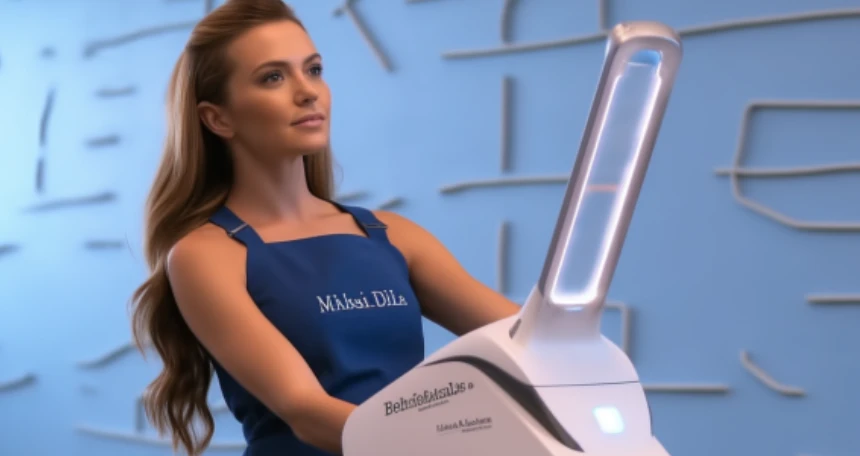Introduction
CO2 laser resurfacing is a popular cosmetic procedure that can help improve the appearance of fine lines, wrinkles, scars, and uneven skin tone. If you're considering this treatment, it's important to understand what to expect as a first-time patient. In this article, we'll provide you with a comprehensive guide to CO2 laser resurfacing, from the initial consultation to the recovery process.

1. Researching the Procedure
Understanding the Basics
Before scheduling a CO2 laser resurfacing treatment, it's crucial to gather information about the procedure. Research the benefits, risks, cost, and expected outcomes. Learn about CO2 lasers, how they work, and what specific skin concerns they address.
Choosing a Qualified Provider
Find a reputable medical spa or dermatologist that specializes in laser resurfacing. Look for credentials, experience, and testimonials to ensure you choose a qualified provider who will deliver safe and effective treatment.
Realistic Expectations
Understand that CO2 laser resurfacing is a significant treatment that requires downtime and may involve discomfort during the recovery process. Discuss your expectations with your provider to ensure they align with the achievable results.
2. Scheduling a Consultation
The Consultation Process
During the consultation, your provider will evaluate your skin and discuss your goals and concerns. They will explain the procedure in detail, including the potential risks and benefits. Feel free to ask questions and address any doubts or fears you may have.
Medical History Assessment
Your provider will ask about your medical history and current medications to determine if CO2 laser resurfacing is suitable for you. Be honest and provide accurate information to ensure your safety and the effectiveness of the treatment.
Preparation Instructions
Your provider will provide you with pre-treatment instructions, such as avoiding sun exposure, certain medications, and skin treatments in the weeks leading up to the procedure. Follow these guidelines carefully to optimize your results and minimize complications.
3. The Day of Treatment
Anesthesia Options
Depending on the depth and extent of the treatment, your provider may offer different anesthesia options, ranging from topical numbing creams to local anesthesia or sedation. Discuss the options with your provider and choose the one that makes you most comfortable.
The Procedure
CO2 laser resurfacing typically takes between 30 minutes to two hours, depending on the treated area. Your provider will use the laser to precisely remove layers of damaged skin, stimulating collagen production and promoting skin rejuvenation.
Possible Discomfort
Although anesthesia helps minimize discomfort, you may still experience some heat, tingling, or stinging during the procedure. Your provider will ensure you are as comfortable as possible throughout the treatment.
Post-Treatment Care
After the procedure, your provider will apply ointments, dressings, or bandages to protect the treated skin. They will provide you with detailed post-treatment instructions, including how to clean, moisturize, and protect your skin during the healing process.
4. Recovery Process
Initial Healing Phase
In the first few days after CO2 laser resurfacing, you can expect redness, swelling, and the formation of a crust that will gradually peel off. Your provider may prescribe pain medication or recommend over-the-counter options to manage any discomfort.
Strict Sun Protection
Protecting your skin from the sun is crucial during the recovery process. Avoid sun exposure, wear SPF daily, and consider using wide-brimmed hats to shield your skin. Sun exposure can cause pigmentation issues and compromise your healing.
Prolonged Healing Phase
As your skin continues to heal, you may notice flaking, dryness, and temporary changes in skin color or texture. Follow your provider's guidelines for proper skincare, including avoiding harsh products and exfoliation until your skin fully recovers.
Follow-Up Appointments
Your provider will schedule follow-up appointments to monitor your progress, assess your results, and address any concerns you may have. Attend these appointments and communicate openly to ensure the best possible outcome.
Frequently Asked Questions (FAQ)
1. How long does it take to see results after CO2 laser resurfacing?
Results can vary, but most patients start seeing initial improvements within one to two weeks after the procedure. Full results may take several months as your skin continues to heal and regenerate.
2. Are there any potential risks or side effects?
Like any medical procedure, CO2 laser resurfacing carries some risks, including infection, scarring, pigmentation changes, and prolonged redness. However, when performed by a skilled professional, the risk of complications is minimized.
3. How long do the results of CO2 laser resurfacing last?
The results of CO2 laser resurfacing can be long-lasting, especially when combined with a good skincare routine and sun protection. However, the natural aging process and lifestyle factors can influence the longevity of results.
4. Can CO2 laser resurfacing be performed on all skin types?
CO2 laser resurfacing can be performed on various skin types, but the approach may vary depending on your skin's specific characteristics. During your consultation, your provider will determine if you are an ideal candidate and discuss any potential limitations.
5. How much does CO2 laser resurfacing typically cost?
The cost of CO2 laser resurfacing can vary depending on several factors, including the treated area's size and the geographical location of the provider. On average, the procedure can range from $1,500 to $4,000 per treatment session.
Conclusion
CO2 laser resurfacing is a comprehensive treatment that requires careful consideration and preparation. By researching the procedure, scheduling a consultation, understanding the day of treatment, and following proper aftercare, you can have a successful experience as a first-time patient. Remember to choose a qualified provider, set realistic expectations, and prioritize sun protection throughout the healing process. With patience and adherence to post-treatment instructions, you can enjoy the transformative effects of CO2 laser resurfacing.
References
1. American Society of Plastic Surgeons, "CO2 Laser Resurfacing," [insert year].
2. Mayo Clinic, "Laser Resurfacing," [insert year].
3. Dermatology Times, "CO2 Laser Resurfacing: Tips for Optimal Outcomes," [insert year].
4. WebMD, "What to Expect after Laser Resurfacing," [insert year].





